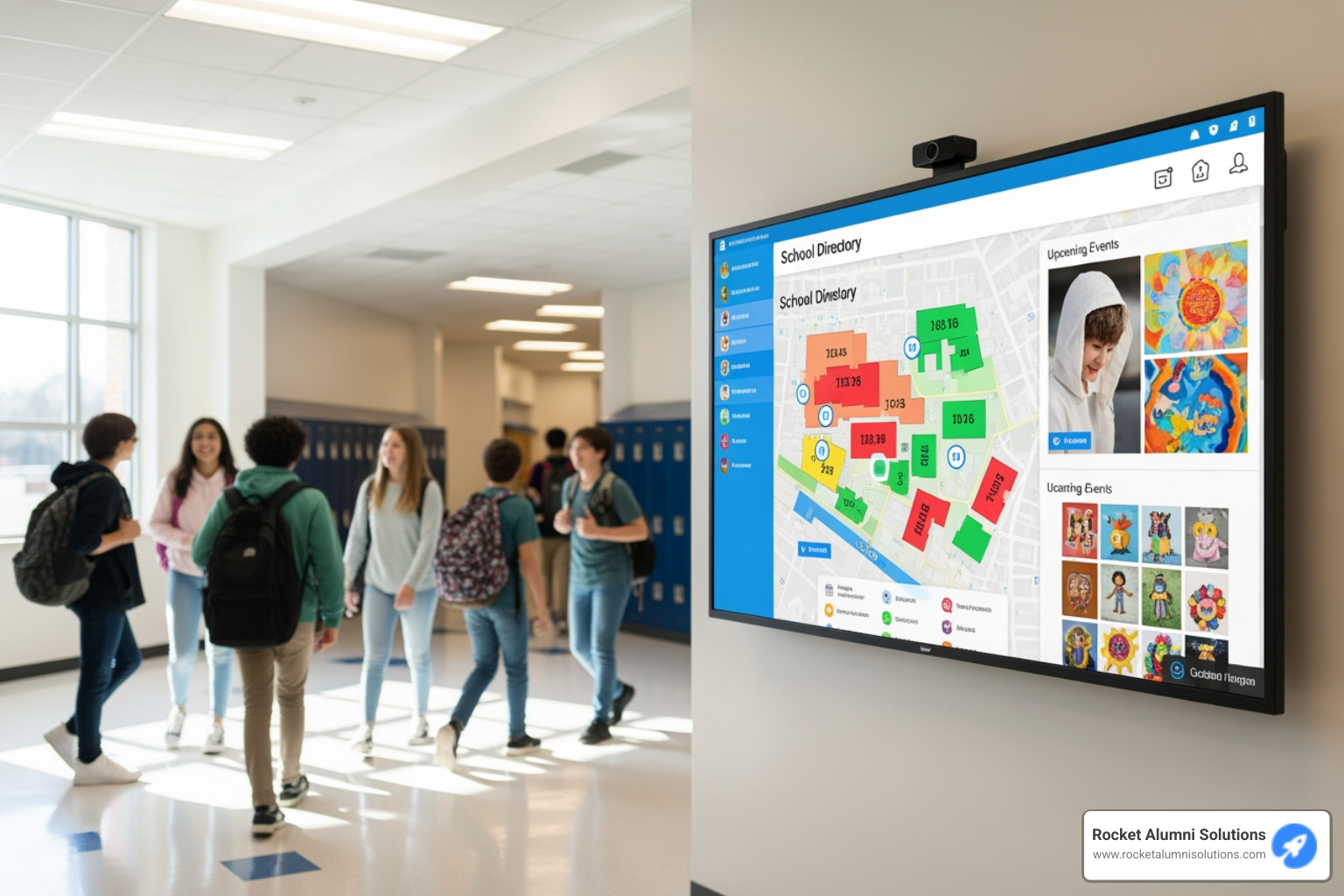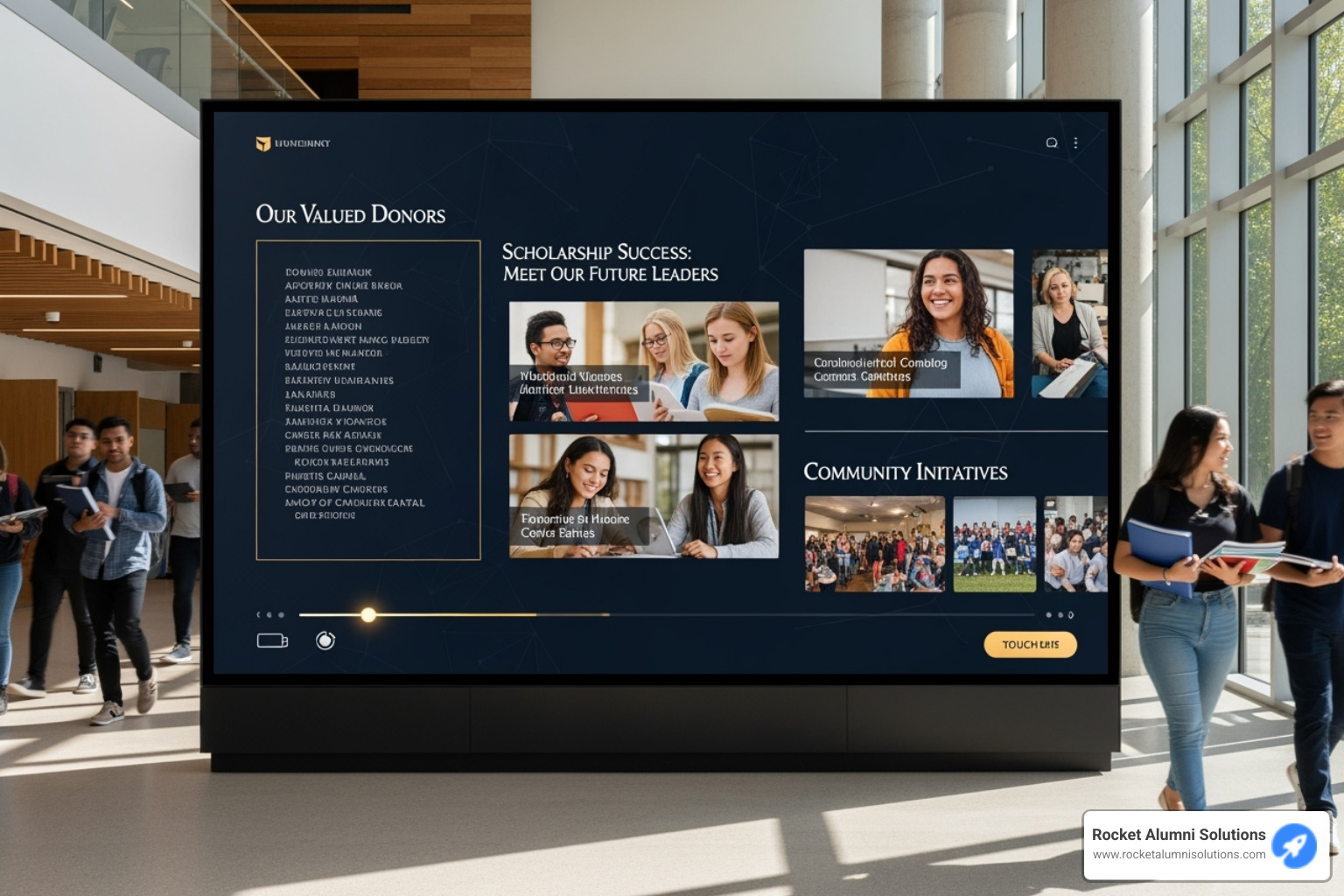Why Digital Interactive Signage is Changing Modern Communication
Digital interactive signage evolves traditional one-way displays into dynamic, two-way communication systems that respond to user input. Unlike static displays that broadcast information, interactive signage invites users to touch, gesture, or speak to access personalized information, complete tasks, or explore content in greater detail.
Key characteristics of digital interactive signage:
- Touch-enabled displays that respond to user input
- Real-time content adaptation based on user interactions
- Data collection capabilities that track user behavior and preferences
- Multi-modal interaction through touch, voice, gestures, or sensors
- Bidirectional communication between the display and the user
The digital signage market is experiencing remarkable growth, projected to expand from USD 20.8 billion in 2019 to USD 29.6 billion by 2024, with interactivity driving this expansion. This growth reflects a shift in communication from passive viewing to active participation.
Whether it's a student exploring alumni achievements on a touchscreen donor wall or a patient checking in at a hospital kiosk, interactive signage transforms static information into engaging conversations. The technology empowers users to control their experience, accessing the information they need, when they need it.
As the founder of Rocket Alumni Solutions, I've seen how digital interactive signage transforms community engagement. It helps schools and organizations increase donor recognition visibility and create meaningful connections through touchscreen displays. My experience has shown me the profound impact of moving from static displays to dynamic, user-driven experiences.
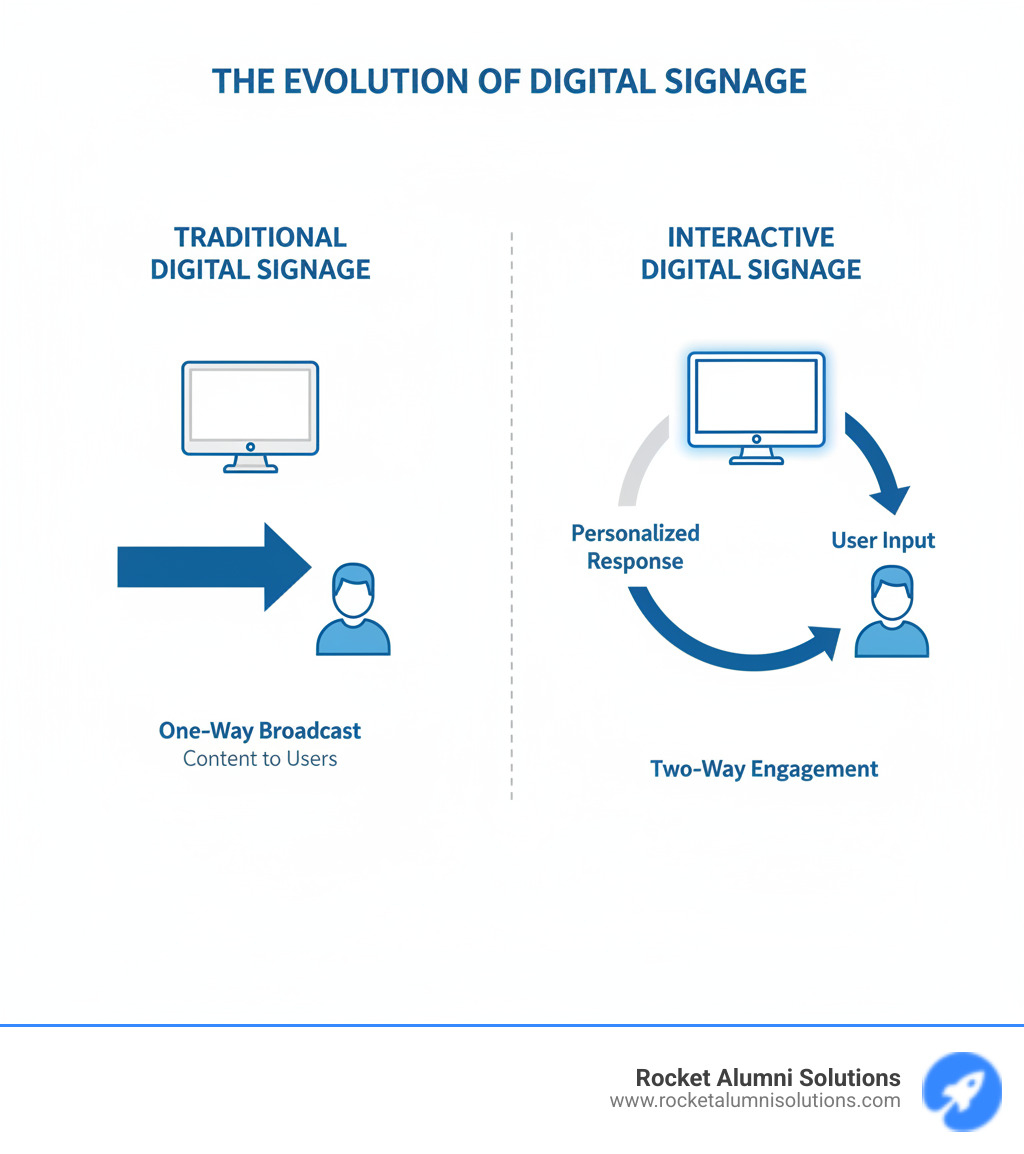
What is Interactive Digital Signage?
Imagine a display that responds to your touch, answering your questions and showing you exactly what you want to see. That's the magic of digital interactive signage - it turns every screen into a conversation.
Unlike traditional displays that broadcast the same message to everyone, interactive signage creates a personal dialogue. When you interact with the screen, it responds with content customized to your needs.
Think of it like playing a video game versus watching a movie. Digital interactive signage transforms passive viewers into active participants, giving them control over their experience.
The digital signage market is expanding rapidly, projected to reach USD 29.6 billion by 2024 from USD 20.8 billion in 2019, at a CAGR of 7.3%. This growth is driven by the power of interactive features to engage users.
Interactive signage also collects valuable data. Every touch and swipe tells a story about user interests. This creates a win-win: users get the information they want, and organizations learn what resonates with their audience.
The contrast is clear:
| Metric | Traditional Digital Signage | Interactive Digital Signage |
|---|
| Engagement | Passive viewing, one-way communication | Active participation, two-way communication |
| Data Collection | Limited (e.g., foot traffic near display) | Rich (user choices, dwell time, navigation paths) |
| User Experience | Broadcast-oriented, generic | Personalized, user-driven, dynamic |
| Content Dynamism | Scheduled playlists, pre-set sequences | Real-time adaptation, on-demand information, user-triggered |
| Purpose | Inform, advertise, entertain (general audience) | Engage, educate, facilitate transactions, collect feedback |
For schools and athletic programs, this technology is a game-changer. Instead of static donor walls, imagine touchscreen displays where visitors can explore alumni achievements, watch highlight videos, or learn about scholarships through simple, intuitive interactions.
The Core Components: Building Your Interactive Experience
Building a digital interactive signage system is like assembling a three-legged stool. The three essential components—hardware, software, and content—must work together to create a stable and useful experience. Getting the balance right determines if your display is an engagement tool or just an expensive, ignored screen.
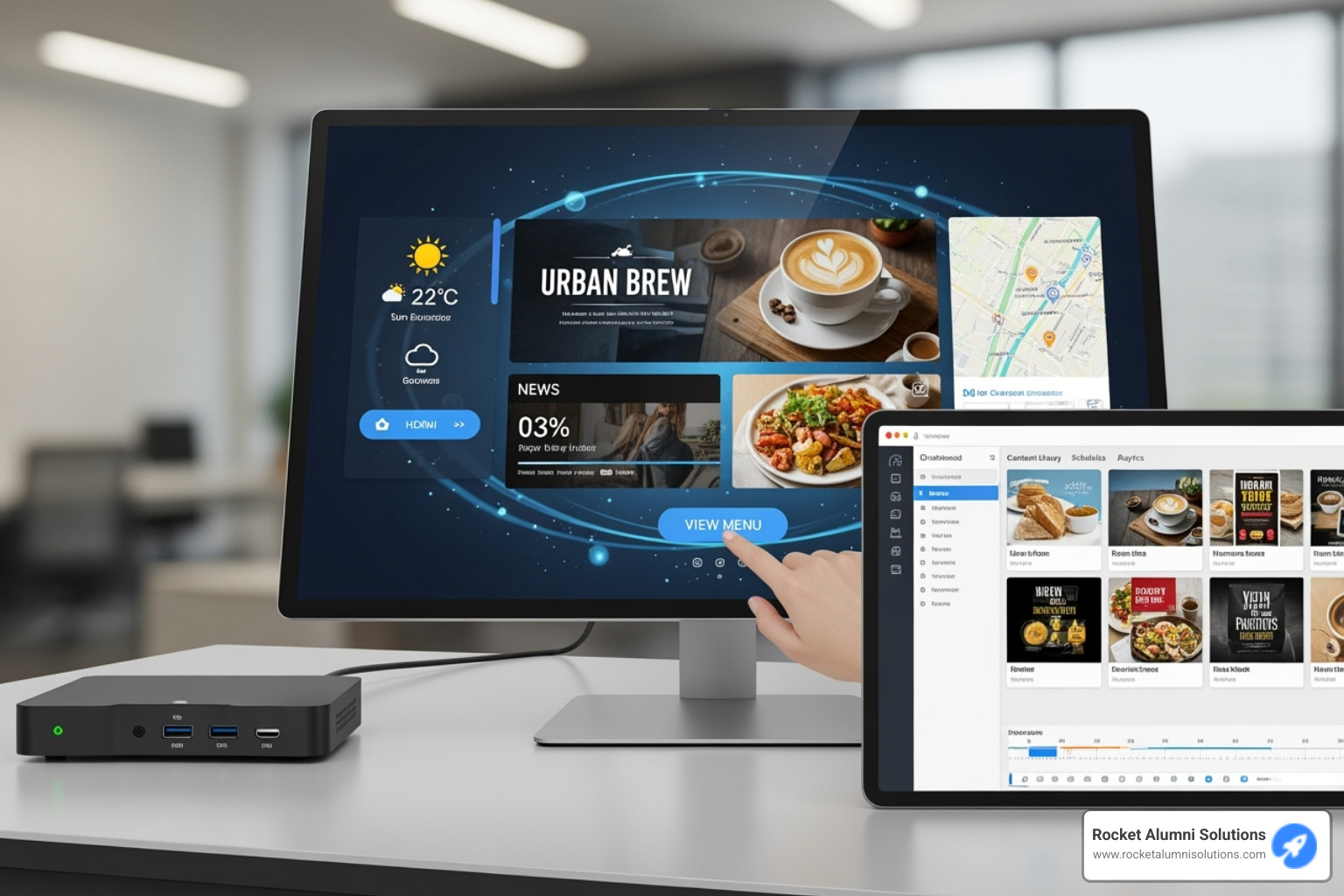
Hardware: The Physical Touchpoint
Hardware is the face of your interactive experience. Commercial-grade displays are the backbone, built to run 24/7 with high brightness and durability. They range from 27-inch units to massive 105-inch displays in resolutions up to 8K.
Touchscreen technology is where interaction begins. The best screens are responsive, support multi-touch, and are built to last. A laggy screen can ruin the user experience.
Media players are the mini-computers that run your content smoothly. They can be integrated into the display or attached separately, ensuring quick responses and stable performance.
Sensors and peripherals like motion sensors, RFID readers, and cameras enable innovative, touchless interactions that can surprise and delight users. Key considerations for hardware are reliability, cost-effectiveness, and ease of use.
Software: The Brains of the Operation
Software is the brain of your display, turning a simple touchscreen into an intelligent system.
A Content Management System (CMS) is your mission control. A good CMS allows easy content creation and updates, scheduling, and remote management of multiple displays from one location.
Content creation tools in modern platforms often feature a "no-code" approach, allowing anyone to build complex interactive presentations without programming.
Analytics and reporting dashboards track user interactions, providing valuable data on content performance to help you understand what's working.
Remote device management is crucial for monitoring system health, pushing updates, and troubleshooting problems without being on-site. Look for software that supports multi-modal interaction, social media integration, cloud-based management, and strong security.
Content: The Heart of the Interaction
Content is what makes your display come alive. It must be an experience that invites exploration.
Dynamic content changes based on user interactions or time of day, keeping the experience fresh.
User-generated content integration creates powerful connections. At Rocket Alumni Solutions, we've seen featuring community stories and social media transform a simple display into a hub for shared memories.
Personalized experiences guide each user to information that matters to them, creating memorable moments.
Storytelling ties it all together, making the interaction feel like a conversation. Best practices for content are to make it intuitive, visually appealing, and regularly updated to keep people coming back.
Opening up the Benefits of Digital Interactive Signage
While the "wow" factor of an interactive screen is great, the real magic of digital interactive signage lies in its practical benefits. It's not just about cool technology; it's about creating value for visitors and improving operational efficiency.
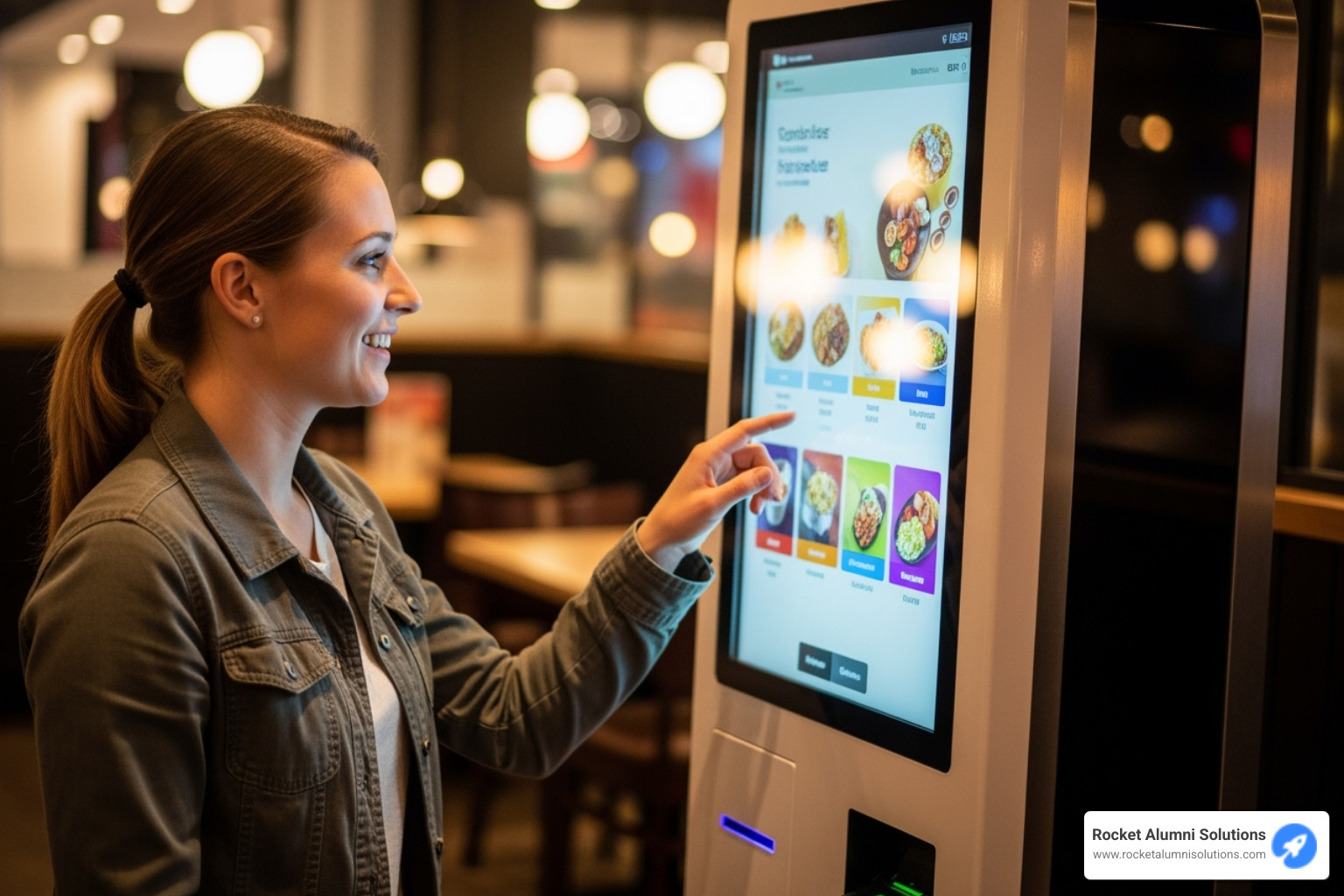
Boost Customer Engagement and Dwell Time
Digital interactive signage turns passive glances into meaningful interactions by giving people control. When visitors can explore content at their own pace, they become more invested. This empowerment of the user creates a sense of ownership.
Self-directed exploration allows the same display to serve multiple audiences, adapting to their individual interests. A prospective student can focus on academics, while an alumnus explores history.
Interactive screens also reduce perceived wait times, turning waiting areas into opportunities for engagement. Most importantly, these interactions create memorable brand experiences that build stronger connections.
Gather Actionable Data and Insights
Every interaction provides valuable insights that static displays cannot.
Understanding user behavior becomes clear when you see what content people prefer. This helps you learn what matters to your community.
Tracking interaction patterns reveals how users steer your content, which is invaluable for improving the experience.
Content performance analytics allow for continuous improvement based on real user data, not guesswork. This leads to data-driven decision making that can inform everything from fundraising to community outreach.
Improve Operational Efficiency
Interactive signage can significantly streamline daily operations, acting as a 24/7 assistant.
Self-service options let visitors find information or access resources without staff assistance, freeing up your team for more complex, high-value interactions.
Wayfinding solutions are valuable in large facilities, providing interactive maps with detailed information and directions.
On-demand information access ensures visitors can get answers immediately, anytime. This technology helps you free up staff resources for activities that require a human touch, resulting in a more efficient operation that better serves visitors.
Bringing Screens to Life: Interactivity and Applications
Imagine a university display that responds to your presence, inviting you to explore stories that unfold with every touch. This is digital interactive signage in action, changing static walls into engaging experiences.
At Rocket Alumni Solutions, we've seen this change repeatedly. A donor wall becomes an animated journey through alumni achievements, allowing students to find their school's history by tapping and swiping.
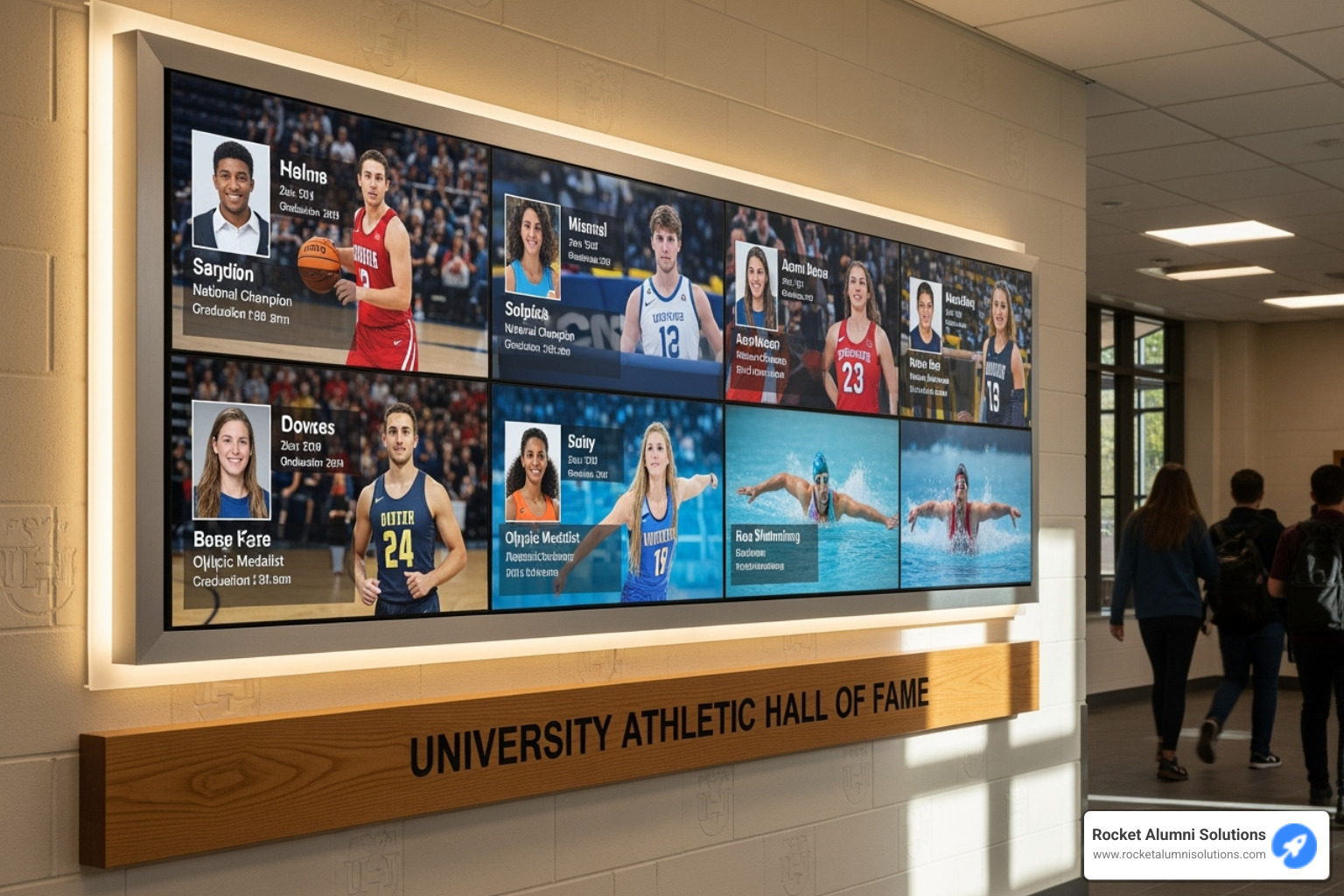
Types of Interactivity in Digital Signage
Modern interactive technology offers many ways for users to connect with content.
Touch and multi-touch gestures are the most intuitive methods, mimicking smartphone use with taps, swipes, and pinches. Multi-touch allows several users to interact simultaneously.
Voice commands are increasingly popular. A user could say, "Show me basketball champions from the 1990s," and the display would respond instantly.
Gesture recognition enables touchless interaction. Users can wave a hand to steer content, using cameras and smart software to interpret movements.
Sensor-based triggers create magical experiences. RFID and NFC can personalize content for users with ID cards. Motion sensors can activate displays as people approach, while proximity sensors can alter content as a user gets closer.
Real-World Use Cases
The versatility of digital interactive signage makes it valuable across many industries.
- Retail: Endless aisle displays allow customers to browse full inventories and configure products.
- Healthcare: Self-check-in kiosks and interactive wayfinding streamline the patient experience in large facilities.
- Corporate: Interactive directories and collaboration tools in meeting rooms improve navigation and productivity.
- Education: This is where we see some of the most meaningful applications. Digital donor walls become storytelling platforms. Interactive learning stations engage students with dynamic content. Digital athletic halls of fame showcase team histories with animated flip books and timelines, while campus maps help with navigation.
- Hospitality: Virtual concierges provide recommendations, and self-ordering kiosks in restaurants speed up service and can increase order values.
The goal is for the technology to feel like a natural conversation, creating genuine connections that strengthen community relationships.
Strategy and Success: Data, ROI, and the Future
Installing digital interactive signage is a smart investment that pays long-term dividends. At Rocket Alumni Solutions, we know the most successful displays are backed by a solid strategy and clear goals. The key is to define success before you begin.
The Role of Data Collection and Analytics
Every interaction on your display provides powerful insights to help you connect with your audience.
Defining what matters most is the first step. For a donor wall, success might be longer engagement times. For a hall of fame, it might be tracking which sports generate the most interest.
Testing different approaches is easy with interactive displays. You can A/B test content to see what performs better, letting the data guide your design choices.
Following the user journey reveals how people steer your content, showing you what they find most compelling.
Creating personal experiences is possible when you understand your audience. If data shows basketball content is popular, you can feature it more prominently while still celebrating all programs.
How to Measure the ROI of Your Investment
Digital interactive signage offers multiple ways to demonstrate its value.
Calculating your return involves comparing gains against costs. For schools, this could mean increased donor engagement leading to higher giving rates.
Tracking meaningful changes in behavior tells the real story. Are more alumni engaging with displays? Are prospective students more engaged during campus visits? These shifts lead to measurable outcomes.
Measuring engagement depth is more than view counts. A five-minute interaction is far more valuable than a passing glance and leads to stronger emotional bonds.
Identifying cost savings adds to your ROI. Interactive displays eliminate printing costs and reduce the need for staff to answer routine questions.
For organizations ready to dive deeper, exploring interactive touchscreen software solutions can help maximize your investment.
Emerging Trends and the Future Outlook
The world of digital interactive signage is moving fast. Staying ahead means understanding what's next.
Artificial intelligence integration is creating more natural, conversational experiences. Imagine a display that answers spoken questions or suggests related content.
Connected device ecosystems will allow displays to sync with smartphones and social media, creating seamless experiences that extend beyond the screen.
Ultra-personalized experiences are the next frontier, with displays adapting to individual interests to create unique journeys for every visitor.
Beyond traditional touch interaction, we're seeing advances in gesture, voice, and even eye-tracking technology, making displays more accessible and intuitive.
The future of digital signage is a platform for connection and storytelling. For more background, consider this further reading on digital signage technologies. The most successful displays will always be those that put human connection at their center.
Conclusion
We've explored how digital interactive signage is changing communication. What began as simple screens has evolved into dynamic platforms that invite conversation, respond to touch, and create meaningful experiences.
This shift from broadcasting to conversing is fundamental. Instead of talking at audiences, we are now talking with them, giving people the power to explore what interests them on their own terms.
For schools and athletic departments, this change is especially exciting. Digital interactive signage from providers like Rocket Alumni Solutions turns static displays into living celebrations of achievement. Imagine students exploring alumni stories through animated flip books or digital yearbooks that come alive with a touch, all through simple, tech-free media.
Technology continues to evolve with AI and the Internet of Things, but the heart of digital interactive signage remains the same: creating connections between people and the stories that matter.
The future is interactive and full of possibilities. Whether you want to celebrate achievements, engage your community, or tell your story more compellingly, the tools are more accessible than ever.
Ready to see how interactive technology can transform your space? Explore our interactive touchscreen software solutions and find how we can bring your vision to life. Your community's stories are waiting to be told-let's make them interactive.


















































































































